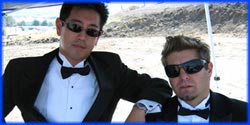


Premier Date: June 10, 2012
busted
As Jamie practiced knife-throwing techniques, Adam made a leather belt holster and worked on quick-drawing with a paintball pistol. They then faced off against each other, standing 16 ft (4.9 m) apart; Jamie used water balloons with the same weight as his knives. Even though Jamie could throw before Adam drew and fired, after several trials Adam was able to shoot Jamie and dodge the thrown balloon.
Next they investigated the scenario of a charging knife wielder. Adam and Jamie determined that Jamie could run 24 ft (7.3 m) before Adam could draw, cock, and fire his pistol. When Jamie ran at Adam with a foam knife from this distance, Adam was able to shoot him; a second test at 20 ft (6.1 m) gave the same result. However, when Jamie started at distances of 16 ft (4.9 m) or less, he successfully stabbed Adam without being shot. They decided that a knife wielder at close quarters could have an advantage over a gunfighter, depending on the circumstances, and declared the myth busted.
busted
After Adam and Jamie received kendo training, Adam built a rig to randomly determine whether he or Jamie would have to attack first, and a second one to indicate when a hit had been scored. Each of 20 bouts ended in either a tie or a victory (defined as being the first to land a blow to the head) for the person who attacked first.
plausible
Kari built two models for small-scale testing, one based on historical drawings, the other with changes to make it more aerodynamic. When placed in a NASA wind tunnel, the first model proved to be highly unstable, but the second did not. For a full-scale model, Tory built an internal quiver to hold the arrows and designed an ignition system to fire them off all at once. The system performed well in the blast chamber, launching the arrows with enough force to embed them deep in the wall.
Building the Fire Dragon to an overall length of 6 ft (1.8 m), the Build Team took it into the desert to fine-tune the ignition timing. The goal was to launch the arrows at the peak of the flight, using a fuse cut to an appropriate length; although the stabilizing fins fell off in midair, the arrows did launch at once.
After a Fire Dragon warhead achieved a range of 800 yd (732 m), as opposed to a single rocket arrow’s 650 yd (594 m), the team set up 10 of the weapons and aimed them at a group of dummies and a castle wall 800 yd (732 m) downrange. Seven of the arrow salvos fired, but only a few arrows landed in the target zone and no targets were hit. The team classified the existence of the Fire Dragon as plausible, but noted that the weapon was highly unreliable.
Previous: Episode 187: Bubble Pack Plunge